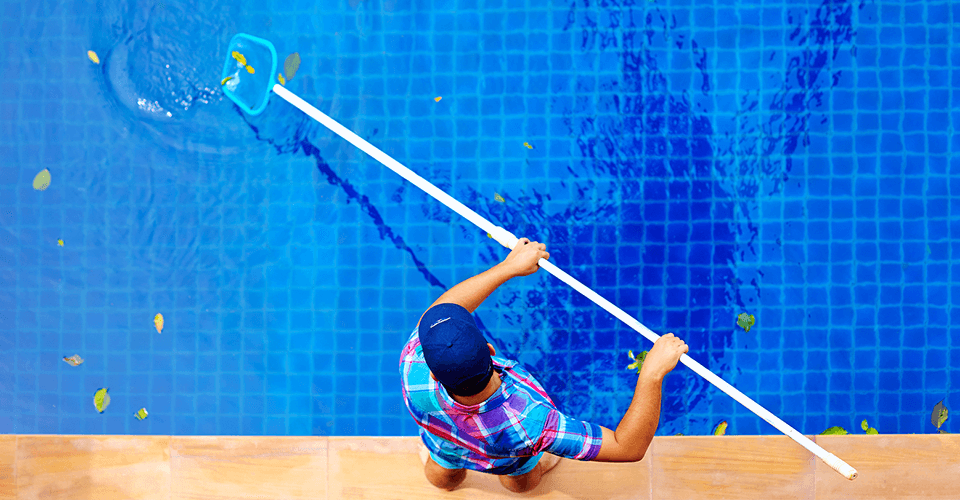There’s no way around it: Lest you end up with a pond filled with frogs, mosquitoes and algae, you need to take care of your pool with routine cleaning and maintenance. Fortunately for you, it’s fairly easy to do most of it yourself with the proper equipment and a regular schedule. If you’re a new pool owner and need help getting started, make sure you cover all these maintenance routines.
Skimming
You’ve probably seen a skimmer. It’s a long pole with a fine, mesh net used for removing floating debris like leaves and dead insects. If you don’t skim your pool, the debris will clog your filters or stain the bottom and sides of your pool. If the filters become clogged, it could affect the circulation system, which will cause further problems. You should skim your pool every few days and empty out the filters and strainer baskets once per week.
Vacuuming
Skimming and filtering won’t catch everything, though. Dirt and dust will make its way to the bottom of the pool, and you’ll need to vacuum regularly to keep things clean. You can opt for a manual or automatic vacuum, but you’ll want to do it every week or so either way.
Brushing
You’ll also need to brush the walls of the pool regularly. If you have a plaster or concrete pool, use a stiffer brush; if you have a fiberglass or vinyl liner pool, then a softer brush is more appropriate. Brush the pool before vacuuming to avoid having to vacuum again!
Cleaning filters
You can get three different kinds of filters, and they all have different cleaning requirements:
- Sand filters must be backwashed and treated with a special sand-cleaning chemical
- Cartridge filters must be removed and sprayed with a hose
- Diatomaceous earth (DE) filters must be backwashed and re-filled with more DE.
Pool heater maintenance
Pool heaters can usually go a few years between servicing, but calcium and other minerals can build up and restrict operation. If you notice any problems with performance, contact a professional to see what’s going on.
Water level
Whether it’s from evaporation or an abundance of cannonballs, you’ll need to occasionally add water to your pool. Check the water level every time you skim, and be sure that it’s no lower than the skimmer basket intakes. Add water with a garden hose as needed, and re-test and re-balance the pH.
Maintaining pH
Your pool should always have a pH between 7.4 and 7.6. Use pH testing kits regularly and make adjustments whenever necessary to keep your pool clean and safe to use. If the pH balance dips too far below that range, it becomes too acidic and can damage the pool and cause skin irritation. If the pH goes above the optimum range, it becomes too alkaline which can clog filters and cloud the water.
Shocking the pool
Over the course of the pool season, chemicals like ammonia and nitrogen can guild up in the water. It’s necessary to add chlorine regularly to combat these contaminants. This is known as “shocking.” When chlorine is added, it bonds with the contaminants and releases them into the air as chloramines (which give your pool that distinctive chlorine smell).
Leak detection
If you have to add water frequently, it’s smart to check for a leak in the pool. To do so, fill a plastic bucket with water and mark the water line on the inside. Place the bucket on your pool steps and mark the water line there. After a couple days, inspect the amount of water lost on both lines; if the pool has lost more water than the bucket, you have a leak, and you must call a professional.
Closing and winterizing
When it comes time to shut the pool down, you’ll want to brush and vacuum the pool and clean all filters and baskets and install a pool cover. If you live in an area with freezing temperatures, you’ll also need to take these winterization steps:
- Empty all water from any plumbing with an air compressor
- Remove remaining water with special antifreeze (NOT car antifreeze)
- Disconnect the pump, heater and chemical feeders, and store the chemical feeders away
- Clean and vacuum the sides and bottom well. Also close the skimmer valves and drain the water about 18” below the pool’s edge to allow room for expansion upon freezing
- Shock treat the water and cover the pool appropriately
Re-opening
When it’s time to re-open again, make sure you knock out all of the following:
- Clear the pool area of all debris and check all filters again
- Refill the pool to its appropriate level and open the skimmer valves to get the water circulating
- Test the pH and perform shock treatment and chemical balance
- Run the pump for 24 hours and re-check the pH
- Continue this cycle of pump/pH check, decreasing the pump runtime by one hour each time, until the pool is balanced
If you’d rather not handle these maintenance routines yourself, you can hire a professional pool servicer who will handle everything. Depending on your location and the size and type of your pool, you can expect to pay $60–$100 per hour for professional cleaning and maintenance services.
If you’re looking for more hot tips to pass along to your clients, check out more at our Splash Promotion blog. If you’re looking for clients to pass these hot tips along to, talk to us at Splash Promotion to find out how we can help you! Call 833-9-SPLASH (833-977-5274) or chat with one of our reps

